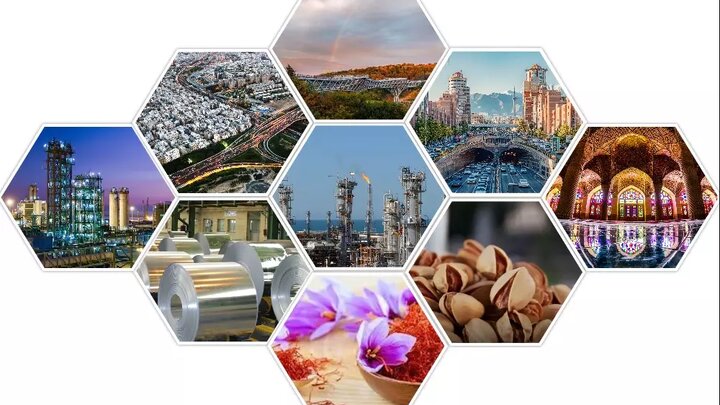Iran (IMNA) - With a well-established nationwide railway system and extensive road infrastructure including numerous highways and freeways, Iran boasts efficient connectivity for the transportation and transit of goods. Additionally, the country's access to international open waters and the integration of major ports with rail and road networks ensure secure and seamless movement of goods.
By focused efforts on increasing cargo volume and expanding the transit rail map, Iran aims to further optimize its potential. Plans include connecting Chabahar to Sarakhs on the Turkmenistan border, as well as linking Khorramshahr to Basra in Iraq, among other shorter routes. These developments have the potential to generate a staggering $26 billion annually through the transit of goods.
Iran's Ambitious Railway Project Holds Promise of Economic Growth and Regional Development
In a significant move to boost economic growth and regional development, Iran has unveiled a groundbreaking railway project. With a staggering value surpassing half of the country's annual oil income, this initiative has the potential to ignite a boom in production and pave the way for job creation for over 1.5 million individuals. Notably, the railway's strategic route will play a pivotal role in the construction and development of the areas it passes through.
Iran, which shares borders with 15 countries housing a population exceeding 600 million people, is poised to tap into vast trade opportunities. Despite a total annual trade volume of over $2 trillion within the region, Iran's current share stands at a mere $36 billion, accounting for approximately 1.7% of the overall trade. This ambitious railway project aims to bolster Iran's trade relations, enabling the nation to expand its economic footprint and strengthen ties with its neighboring countries.
Iran Aims to Increase Trade Volume and Job Creation through Regional Economic Diplomacy and Mineral Reserves
Iran, a country with a trade volume of approximately $100 billion in both oil and non-oil sectors, is seeking to bolster its economy by activating regional economic diplomacy. By leveraging bilateral monetary agreements and indirect banking, Iran aims to increase its share of regional trade by a mere 5%, which could potentially raise the trade volume to $100 billion.
Experts estimate that achieving this goal could lay the groundwork for the creation of 4 million jobs within the country, even in the most pessimistic scenario. This ambitious plan highlights Iran's commitment to economic growth and job opportunities through strategic international partnerships.
Furthermore, Iran boasts significant mineral reserves, totaling a staggering 104 billion tonnes. Situated on a major orogenic belt, these reserves account for approximately 7% of the world's total. Among the 68 types of minerals present, Iran possesses 6% of the world's copper, 3.5% of lead and zinc, 10.5% of coal, and 2% of iron ore resources.
The abundance of mineral wealth positions Iran as a key player in the global mining industry, offering vast opportunities for domestic and international investment. With careful management and sustainable practices, the development of these reserves could further contribute to Iran's economic growth and diversification.
Iran's Mineral Reserves Valued at $700 Billion, Infrastructure Development Key to Unlocking $4 Trillion Potential
Iran's mineral reserves are currently valued at a staggering $700 billion, presenting a significant economic opportunity for the country. To fully realize its potential, experts estimate that a value-added of $4 trillion can be achieved through strategic measures such as infrastructure development, raw material processing, private sector entry, and increased exports.
Despite the immense potential of the mining sector, it has been overshadowed by the discovery of oil, resulting in neglect and limited focus on other sectors, including agriculture. This oversight is particularly concerning given that agriculture plays a crucial role in ensuring food security and is considered one of the most important economic sectors in Iran.
By implementing scientific management and cultivation techniques in agricultural lands, Iran can not only boost production and create employment opportunities but also enhance food security. Moreover, such measures can lead to cheaper access to agricultural products for the population, benefiting both consumers and the economy.
To unlock the full potential of Iran's mineral reserves and address the neglected sectors, prioritizing infrastructure development and adopting innovative approaches will be crucial. By doing so, Iran can pave the way for significant economic growth, job creation, and improved living standards for its citizens.
Iran's Abundant Resources and Strategic Location Present Opportunities for Economic Advancement
In terms of energy production, countries like South Korea, Japan, and several European nations heavily rely on one crucial input: energy. However, Iran holds a unique advantage due to its geographical location. Situated in a region that accounts for over 48% of the world's oil and gas reserves, Iran itself possesses the largest combined reserves of these resources.
Moreover, Iran boasts an array of natural resources, fertile lands, and valuable mines. Its population is characterized by a skilled, educated, and dedicated workforce, further enhancing the country's potential for progress.
Realizing this potential requires meticulous and knowledgeable management practices. By harnessing the capabilities across various sectors, Iran can transform its economy into a thriving and resilient foundation for sustained growth.
Iran's Strategies to Boost Production and Address Livelihood Challenges
In an effort to enhance production capabilities and tackle livelihood issues, Iran is focusing on strengthening economic-political interactions and forging bilateral or multilateral monetary agreements with regional countries. The completion of the rail network, with the assistance of the private sector, is also a priority.
Additionally, Iran recognizes the significance of the mining and processing sector and aims to allocate special attention to its natural resources.
Active engagement in the reconstruction of war-torn nations like Iraq and Syria is deemed crucial for Iran's overall development and stability.
Furthermore, Iran plans to revamp its irrigation network by implementing reforms in water consumption and efficiency patterns.


Your Comment